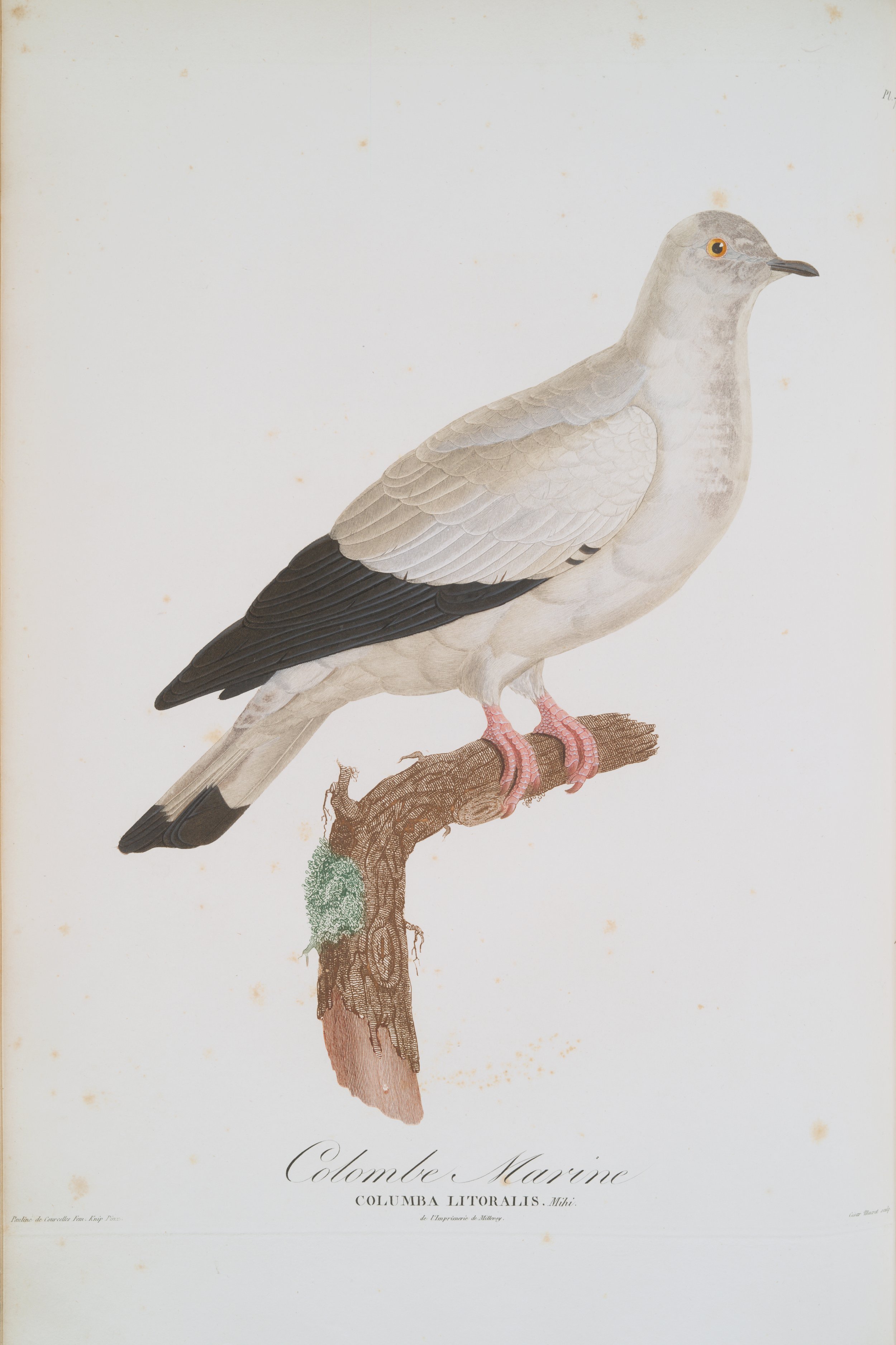 Image 1 of 2
Image 1 of 2

 Image 2 of 2
Image 2 of 2



Les Pigeons - Columba Nicobarica
Originally published c. 1808. Reissued by Carthay Studio.
Long before they were scorned as city-dwelling snack thieves, pigeons were the crowned royalty of rooftops and rotundas. And no one captured their glory better than Pauline de Courcelles—known in polite society (and scandal sheets) as Madame Knip.
Her illustrations, lifted from the early 19th-century masterwork Les Pigeons, are nothing short of avian theater. These aren’t birds; they’re icons—posed, painted, and practically strutting off the page. With velvet plumage and just the right tilt of the head, each one is part scientific study, part aristocratic portrait, and wholly fabulous.
But don’t be fooled by the feathers. Les Pigeons is steeped in intrigue. What began as a collaboration with Dutch naturalist C.J. Temminck ended in a deliciously bold act of reclamation: Knip seized the project, slapped on a new title page, and dedicated the whole thing to Empress Marie Louise. A woman after our own heart.
• Paper thickness: 10.3 mil
• Paper weight: 189 g/m²
• Opacity: 94%
• ISO brightness: 104%
• Paper is sourced from Japan
Ideal for
Ornithologists. Scandal enthusiasts. Admirers of plumage and panache.
This piece is printed just for you the moment you order. It takes a touch longer to arrive, but that’s the beauty of made-to-order: less waste, more intention. Consider it a small act of elegance in a world of excess.
Originally published c. 1808. Reissued by Carthay Studio.
Long before they were scorned as city-dwelling snack thieves, pigeons were the crowned royalty of rooftops and rotundas. And no one captured their glory better than Pauline de Courcelles—known in polite society (and scandal sheets) as Madame Knip.
Her illustrations, lifted from the early 19th-century masterwork Les Pigeons, are nothing short of avian theater. These aren’t birds; they’re icons—posed, painted, and practically strutting off the page. With velvet plumage and just the right tilt of the head, each one is part scientific study, part aristocratic portrait, and wholly fabulous.
But don’t be fooled by the feathers. Les Pigeons is steeped in intrigue. What began as a collaboration with Dutch naturalist C.J. Temminck ended in a deliciously bold act of reclamation: Knip seized the project, slapped on a new title page, and dedicated the whole thing to Empress Marie Louise. A woman after our own heart.
• Paper thickness: 10.3 mil
• Paper weight: 189 g/m²
• Opacity: 94%
• ISO brightness: 104%
• Paper is sourced from Japan
Ideal for
Ornithologists. Scandal enthusiasts. Admirers of plumage and panache.
This piece is printed just for you the moment you order. It takes a touch longer to arrive, but that’s the beauty of made-to-order: less waste, more intention. Consider it a small act of elegance in a world of excess.
Originally published c. 1808. Reissued by Carthay Studio.
Long before they were scorned as city-dwelling snack thieves, pigeons were the crowned royalty of rooftops and rotundas. And no one captured their glory better than Pauline de Courcelles—known in polite society (and scandal sheets) as Madame Knip.
Her illustrations, lifted from the early 19th-century masterwork Les Pigeons, are nothing short of avian theater. These aren’t birds; they’re icons—posed, painted, and practically strutting off the page. With velvet plumage and just the right tilt of the head, each one is part scientific study, part aristocratic portrait, and wholly fabulous.
But don’t be fooled by the feathers. Les Pigeons is steeped in intrigue. What began as a collaboration with Dutch naturalist C.J. Temminck ended in a deliciously bold act of reclamation: Knip seized the project, slapped on a new title page, and dedicated the whole thing to Empress Marie Louise. A woman after our own heart.
• Paper thickness: 10.3 mil
• Paper weight: 189 g/m²
• Opacity: 94%
• ISO brightness: 104%
• Paper is sourced from Japan
Ideal for
Ornithologists. Scandal enthusiasts. Admirers of plumage and panache.
This piece is printed just for you the moment you order. It takes a touch longer to arrive, but that’s the beauty of made-to-order: less waste, more intention. Consider it a small act of elegance in a world of excess.










